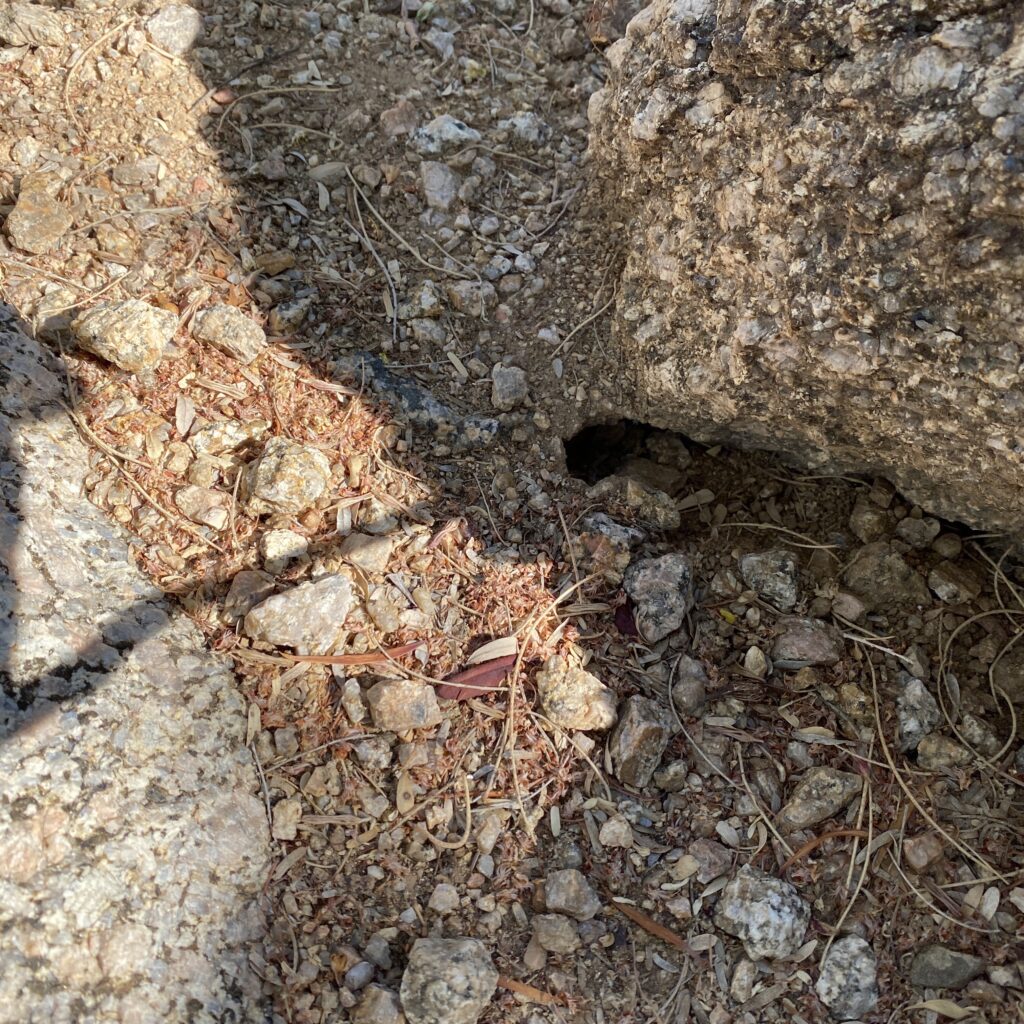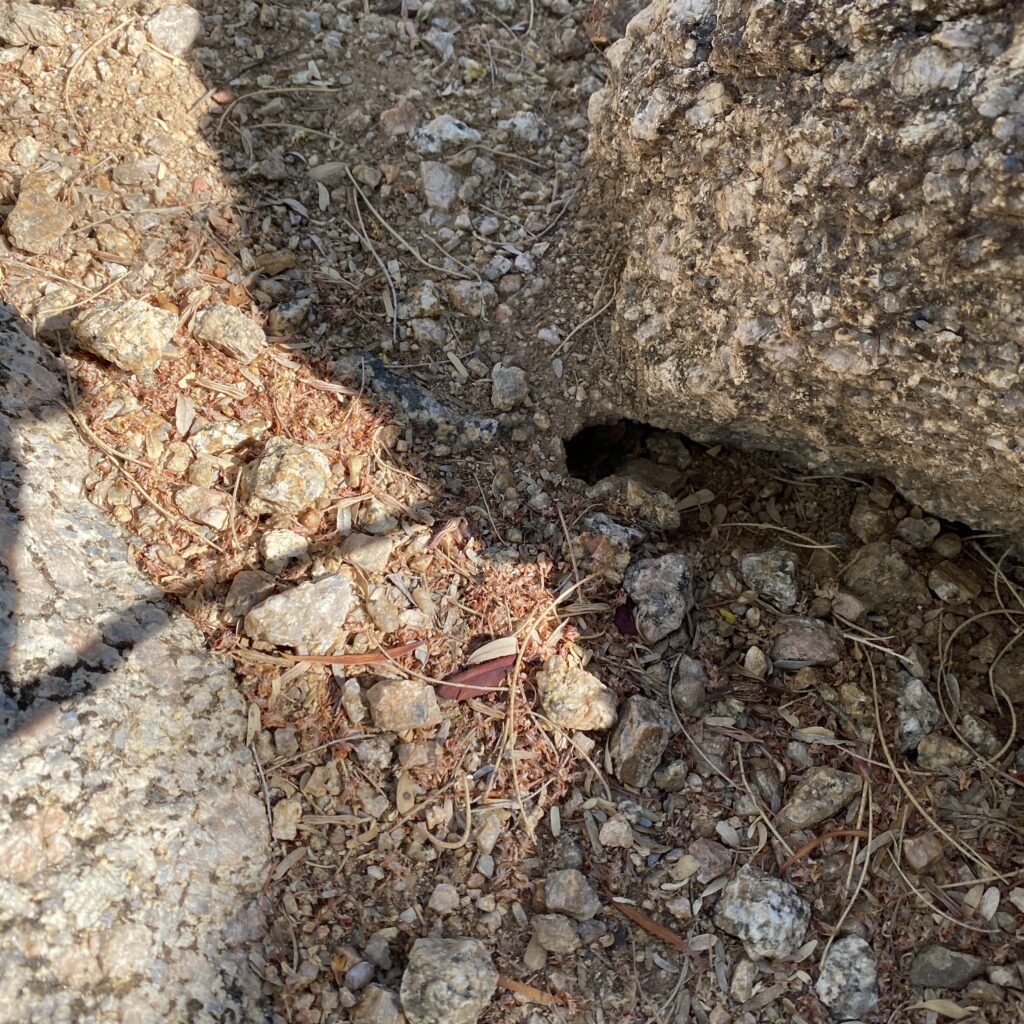Rattlesnakes are one of the most feared creatures in the world, and it’s no surprise why. They are venomous and deadly, making them a danger to humans and pets alike. But have you ever wondered if these slithering serpents also dig holes?
Many people believe that rattlesnakes are capable of digging holes, while others argue that they are not. In this article, we will explore the truth behind this popular myth and uncover the facts about rattlesnake behavior. So, let’s dive in and discover whether or not these venomous vipers are really digging holes in your backyard.
Rattlesnakes do not dig holes, but they may use abandoned animal burrows or create temporary shelters by pushing aside leaves, rocks, or other debris. They are not known for digging their own burrows or dens, but rather rely on existing structures for shelter.

Do Rattlesnakes Dig Holes?
Rattlesnakes are known for their distinct rattling sound and venomous bite. But, have you ever wondered if they dig holes? In this article, we will explore the digging habits of rattlesnakes and their behavior towards burrowing.
1. Rattlesnake Habitat
Rattlesnakes are found in a variety of habitats, including deserts, grasslands, forests, and wetlands. They prefer areas with ample vegetation, rocky outcroppings, and open areas for basking. These areas often have suitable burrows for hiding and hibernating during winter months.
Rattlesnakes are known to use abandoned animal burrows, rock crevices, and other natural cavities for shelter. They may also dig shallow depressions in the ground for cooling off during hot weather. However, they do not typically dig extensive burrows or tunnels.
2. Rattlesnake Burrowing Behavior
While rattlesnakes do not dig burrows on their own, they may use existing holes as a temporary shelter. They may also share burrows with other snakes or animals, such as rodents, rabbits, or ground squirrels.
Rattlesnakes may also use their bodies to create shallow depressions in the ground, which they use for thermoregulation. By flattening their bodies against the ground, they can absorb heat from the sun or cool off in shaded areas.
3. Benefits of Rattlesnake Burrowing
Rattlesnakes play an important role in many ecosystems as predators of small mammals and insects. Their burrowing behavior helps to maintain soil health and structure, as well as provide shelter for other animals.
Additionally, rattlesnakes help to control rodent populations, which can prevent the spread of diseases and damage to crops. By keeping rodent populations in check, rattlesnakes help to maintain a healthy balance in the ecosystem.
4. Rattlesnakes vs Other Burrowing Animals
While rattlesnakes may share burrows with other animals, they do not typically compete with true burrowing animals, such as moles or gophers. These animals have specialized adaptations for digging, such as strong forelimbs and sharp claws, which allow them to create extensive burrow systems.
Rattlesnakes, on the other hand, rely on natural cavities and shallow depressions for shelter, and do not have the physical adaptations for extensive digging.
5. Rattlesnake Safety Tips
If you live in an area where rattlesnakes are present, it is important to take precautions to avoid snake bites. Here are some tips to keep in mind:
– Wear protective clothing and sturdy boots when hiking or working outdoors.
– Stay on designated trails and avoid tall grass or brushy areas.
– Watch where you step and avoid putting your hands or feet in areas where you cannot see.
– Keep pets on a leash and away from areas where snakes may be present.
– If you encounter a rattlesnake, give it plenty of space and do not attempt to handle or disturb it.
6. Conclusion
While rattlesnakes may use existing burrows or create shallow depressions in the ground, they do not typically dig extensive burrows or tunnels. Their burrowing behavior helps to maintain soil health and structure, as well as provide shelter for other animals. By understanding their habits and behavior, we can coexist with these important predators and maintain a healthy balance in the ecosystem.
Frequently Asked Questions
Many people wonder about the behavior and habitat of rattlesnakes. One question that comes up frequently is whether rattlesnakes dig holes. Here are some answers to this question and related topics.
What Are Rattlesnakes’ Preferred Habitats?
Rattlesnakes are found in a variety of habitats, from deserts to forests to grasslands. They prefer areas with plenty of cover, such as rocks, logs, and vegetation. They also need a source of water and prey, such as rodents, birds, and other small animals. Rattlesnakes are known to hibernate in underground dens during the winter months, which can be located in rocky outcroppings or other sheltered areas.
While rattlesnakes do not dig their own holes, they may use existing burrows or crevices in rocks or logs as shelter. They may also seek out areas with loose soil or sand to burrow into for protection from extreme temperatures or predators.
What Type of Burrows Do Rattlesnakes Use?
Rattlesnakes are not known for digging their own burrows, but they may use holes or burrows created by other animals, such as rodents or rabbits. They may also seek out crevices in rocks or logs or under vegetation for shelter. Rattlesnakes may also use abandoned mammal burrows, such as those of ground squirrels or prairie dogs, as hibernation sites.
Rattlesnakes are known to be opportunistic in their choice of shelter and will use whatever is available in their environment to protect themselves from extreme temperatures or predators.
Do Rattlesnakes Dig Their Own Burrows?
Rattlesnakes are not known for digging their own burrows, as they do not have the physical adaptations for burrowing like some other snake species. However, they are capable of moving soil and debris with their bodies, which can create the appearance of a hole or burrow.
Rattlesnakes may also use their bodies to excavate shallow depressions in sandy or loose soil, which can provide them with temporary shelter from extreme temperatures or predators. However, these depressions are not true burrows and are not used for hibernation or long-term shelter.
What Are Some Signs That Rattlesnakes Are in the Area?
While rattlesnakes are generally shy and avoid contact with humans, there are some signs that they may be in the area. One common sign is the presence of shed snakeskin, which can be found near rocks or other areas where rattlesnakes may be sheltering.
Other signs include the presence of rodent or small mammal burrows, as rattlesnakes may use these for shelter. Rattlesnakes may also leave tracks or trails in sandy or loose soil, which can be identified by their distinctive diamond-shaped footprints.
What Should I Do If I Encounter a Rattlesnake?
If you encounter a rattlesnake, it is important to give the animal plenty of space and avoid approaching or provoking it. Rattlesnakes may strike if they feel threatened or cornered, so it is best to keep a safe distance and allow the snake to move away on its own.
If you are hiking or camping in an area where rattlesnakes are known to live, it is a good idea to wear sturdy shoes and long pants to protect yourself from snake bites. You can also carry a snakebite kit and know how to use it in case of an emergency.
Inside a Rattlesnake Den 4K
In conclusion, it is clear that rattlesnakes do not dig holes. While they may use existing burrows or other natural crevices for shelter, they do not possess the physical ability to dig their own holes. Instead, they rely on their excellent hunting skills and venomous bite to survive in their natural habitats.
It is important to note that while rattlesnakes are often feared and misunderstood, they play an important role in their ecosystems. As predators, they help control rodent populations and maintain the balance of nature. It is crucial that we educate ourselves and others about these fascinating and beneficial creatures.
Overall, while rattlesnakes may not dig holes themselves, they are still an important and fascinating part of the natural world. By learning more about them and their behaviors, we can help promote their conservation and better understand the role they play in our environment.


